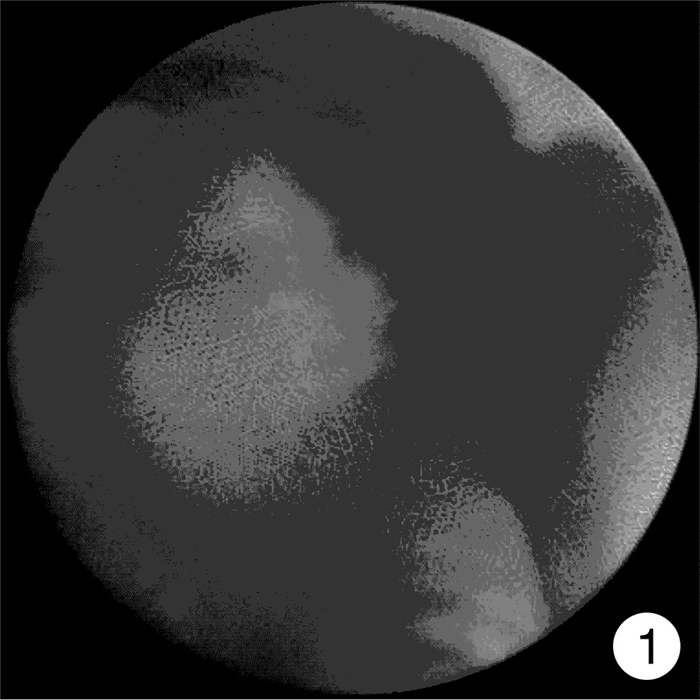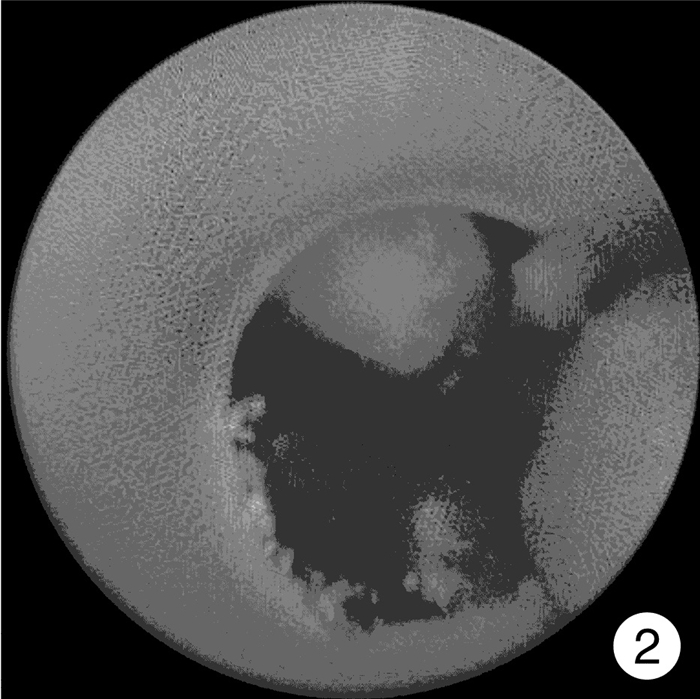Comparative study between improved and traditional balloon dilatation in establishing percutaneous renal channels for treatment of renal calculus patients with non-dilated collecting system
-
摘要: 目的 探讨超声引导下改良球囊扩张法建立无积水肾皮肾通道的安全性和有效性,并与传统球囊扩张法比较。方法 收集2017年3月—2021年3月就诊于郑州大学第一附属医院泌尿外科无积水肾结石患者的临床资料,对行改良球囊扩张法及传统球囊扩张法建立皮肾通道患者的临床资料进行倾向性匹配及回顾性分析。结果 倾向性评分匹配后,共有80例(40对)患者纳入研究,其中改良球囊扩张组40例和传统球囊扩张组40例,2组患者的临床资料一致性较好。改良球囊扩张组建立通道一次性成功率高于传统球囊扩张组(97.5% vs. 80.0%),差异有统计学意义(P < 0.05)。改良球囊扩张组结石清除率高于传统球囊扩张组(85.0% vs. 75.0%),但差异无统计学意义(P>0.05)。改良球囊扩张组术中建立通道的时间较传统球囊扩张组术长[(8.0±1.4) min vs.(6.3±1.8) min],差异有统计学意义(P < 0.05);但改良球囊扩张组的总体手术时间较传统球囊扩张组更短[(68.7±9.8) min vs.(73.6±12.0) min],差异有统计学意义(P < 0.05)。2组患者在出血量、输血率及术后并发症等方面比较差异无统计学意义。结论 改良球囊扩张组建立经皮肾镜通道治疗无积水肾结石患者,可显著提高一次建立通道成功率,缩短总体手术时间。改良球囊扩张建立经皮肾通道方法精准可靠,能明显提高手术安全性。Abstract: Objective To compare the efficacy and security between improved balloon dilatation and conventional balloon dilatation for channel establishment in percutaneous nephrolithotomy (PCNL) for renal calculus patients with non-dilated collecting system.Methods Clinical data of renal calculus patients with non-dilated collecting system in the department of urology of First Affiliated Hospital of Zhengzhou University from March 2017 to March 2021 were collected, and propensity matching analysis and retrospective analysis of the clinical data of patients with improved balloon dilatation method and traditional balloon dilatation method were conducted.Results Eighty pairs of patients were enrolled in the study after propensity score matching. The clinical data of the two groups of patients were well balanced. The success rates of access at the first time of two groups were 97.5% and 80.0% (P < 0.05), respectively. The stone clearance rates were 85.0% and 75.0% (P > 0.05), respectively. The average time of establishing the renal access of two groups were (8.0±1.4) min and (6.3±1.8) min (P < 0.05), but the overall surgical time of two groups were (68.7±9.8) min and (73.6± 12.0) min (P < 0.05). Additionally, there was no difference in terms of incidence of complications or incidence of blood transfusion between the two groups. The difference was not statistically significant in blood loss (P > 0.05).Conclusion The establishment of percutaneous nephroscopy channel for renal calculus patients with non-dilated collecting system can significantly improve the success rate at the first time channel establishment and shorten the overall surgical time. The impoved balloon dilatation is accurate and reliable, which can significantly improve the surgical safety.
-
Key words:
- renal calculus /
- balloon dilatation /
- percutaneous nephrolithotomy
-

-
表 1 倾向性匹配分析前2组临床一般资料
例(%),X±S 项目 改良球囊扩张组
(n=44)传统球囊扩张组
(n=65)t/χ2 P值 性别 0.31 0.434 男 28(63.63) 46(70.77) 女 16(36.37) 19(29.23) 结石类型 7.00 0.030 完全鹿角形结石 8(18.18) 15(23.08) 不完全鹿角形结石 22(50.00) 18(27.69) 单纯肾盏结石 14(31.82) 32(49.23) 患肾既往手术史 4.24 0.039 是 6(13.64) 20(30.77) 否 38(86.36) 45(69.23) 年龄/岁 54.0±5.1 54.7±3.6 0.71 0.481 BMI/(kg·m-2) 24.8±3.4 24.3±3.0 0.69 0.495 结石最大直径/cm 4.3±1.2 4.5±1.1 0.89 0.376 表 2 倾向性匹配分析后2组临床一般资料
例(%),X±S 项目 改良球囊扩张组
(n=40)传统球囊扩张组
(n=40)t/χ2 P值 性别 0.05 0.818 男 24(60.00) 25(62.50) 女 16(40.00) 15(37.50) 结石类型 0.21 0.901 完全鹿角形结石 7(17.50) 8(20.00) 不完全鹿角形结石 20(50.00) 18(45.00) 单纯肾盏结石 13(32.50) 14(35.00) 患肾既往手术史 <0.001 1.000 是 5(12.50) 5(12.50) 否 35(87.50) 35(87.50) 年龄/岁 54.6±5.0 54.4±3.5 0.12 0.904 BMI/(kg·m-2) 24.5±3.5 24.6±2.9 0.19 0.850 结石最大直径/cm 4.0±1.1 3.9±1.2 0.24 0.810 表 3 2组手术资料比较分析
例(%),X±S 项目 改良球囊扩张组
(n=40)传统球囊扩张组
(n=40)t/χ2 P值 通道建立时间/min 8.0±1.4 6.3±1.8 4.77 0.001 建立通道一次性成功 39(97.5) 32(80.0) 4.51 0.034 手术时间/min 68.7±9.8 73.6±12.0 2.01 0.047 出血量/mL 86.1±13.3 90.3±11.3 1.51 0.134 结石清除 34(85.0) 30(75.0) 1.25 0.264 手术并发症发生 8(20.0) 10(25.0) 0.28 0.592 输血情况 1(2.5) 2(5.0) 0.00 1.000 -
[1] Antonelli JA, Pearle MS. Advances in percutaneous nephrolithotomy[J]. Urol Clin North Am, 2013, 40(1): 99-113. doi: 10.1016/j.ucl.2012.09.012
[2] 李建兴, 肖博. 经皮肾镜手术通道的发展与创新[J]. 临床泌尿外科杂志, 2020, 35(9): 679-683. doi: 10.13201/j.issn.1001-1420.2020.09.001
[3] 李攀, 李炯明, 冯伟. 穿刺技术在经皮肾镜取石术通道建立中的现况[J]. 临床泌尿外科杂志, 2015, 30(03): 277-279. doi: 10.13201/j.issn.1001-1420.2015.03.026
[4] Zhang XJ, Zhu ZJ, Wu JJ. Application of Clavien-Dindo Classification System for Complications of Minimally Invasive Percutaneous Nephrolithotomy[J]. J Healthc Eng, 2021, 2021: 5361415.
[5] Türk C, Petřík A, Sarica K, et al. EAU Guidelines on Interventional Treatment for Urolithiasis[J]. Eur Urol, 2016, 69(3): 475-482. doi: 10.1016/j.eururo.2015.07.041
[6] Tepeler A, Armaǧan A, Akman T, et al. Impact of percutaneous renal access technique on outcomes of percutaneous nephrolithotomy[J]. J Endourol, 2012, 26(7): 828-833. doi: 10.1089/end.2011.0563
[7] Usawachintachit M, Masic S, Allen IE, et al. Adopting Ultrasound Guidance for Prone Percutaneous Nephrolithotomy: Evaluating the Learning Curve for the Experienced Surgeon[J]. J Endourol, 2016, 30(8): 856-863. doi: 10.1089/end.2016.0241
[8] 潘铁军, 郑秋平, 李功成, 等. 球囊扩张结合腰肋悬空仰卧位经皮肾镜取石术的临床研究[J]. 中华泌尿外科杂志, 2014, 35(3): 209-211. doi: 10.3760/cma.j.issn.1000-6702.2014.03.013
[9] 肖龙明, 杨巧智, 陈建发, 等. 球囊与筋膜扩张法建立经皮肾镜标准通道的比较[J/OL]. 中华腔镜泌尿外科杂志(电子版), 2016, 10(4): 34-37.
[10] Nouralizadeh A, Sharifiaghdas F, Pakmanesh H, et al. Fluoroscopy-free ultrasonography-guided percutaneous nephrolithotomy in pediatric patients: a single-center experience[J]. World J Urol, 2018, 36(4): 667-671. doi: 10.1007/s00345-018-2184-z
[11] 王健明, 刘杰, 朱文彬, 等. B超联合实时彩色多普勒超声在降低经皮肾镜取石术出血并发症中的意义[J]. 中华泌尿外科杂志, 2016, 37(2): 95-97. doi: 10.3760/cma.j.issn.1000-6702.2016.02.005
[12] 李建兴, 肖博, 唐宇哲, 等. 融合影像技术在超声定位经皮肾镜手术中的初步应用[J]. 中华泌尿外科杂志, 2017, 38(9): 658-661. doi: 10.3760/cma.j.issn.1000-6702.2017.09.005
[13] 苏博兴, 王樹, 肖博, 等. 全超声监控建立标准通道行经皮肾镜手术的安全性及有效性分析[J]. 中华泌尿外科杂志, 2019, 40(8): 615-618. doi: 10.3760/cma.j.issn.1000-6702.2019.08.012
[14] Preminger GM, Assimos DG, Lingeman JE, et al. Chapter 1: AUA guideline on management of staghorn calculi: diagnosis and treatment recommendations[J]. J Urol, 2005, 173(6): 1991-2000. doi: 10.1097/01.ju.0000161171.67806.2a
[15] El-Shazly M, Salem S, Allam A, et al. Balloon dilator versus telescopic metal dilators for tract dilatation during percutaneous nephrolithotomy for staghorn stones and calyceal stones[J]. Arab J Urol, 2015, 13(2): 80-83. doi: 10.1016/j.aju.2014.12.004
[16] Pathak AS, Bellman GC. One-step percutaneous nephrolithotomy sheath versus standard two-step technique[J]. Urology, 2005, 66(5): 953-957. doi: 10.1016/j.urology.2005.05.031
[17] Kim HY, Choe HS, Lee DS, Yoo JM, Lee SJ. Is Absence of Hydronephrosis a Risk Factor for Bleeding in Conventional Percutaneous Nephrolithotomy[J]. Urol J, 2020, 17(1): 8-13.
[18] Wang Y, Jiang F, Wang Y, et al. Post-percutaneous nephrolithotomy septic shock and severe hemorrhage: a study of risk factors[J]. Urol Int, 2012, 88(3): 307-310. doi: 10.1159/000336164
[19] Jin W, Song Y, Fei X. The Pros and cons of balloon dilation in totally ultrasound-guided percutaneous Nephrolithotomy[J]. BMC Urol, 2020, 20(1): 82. doi: 10.1186/s12894-020-00654-x
[20] Maynes LJ, Desai PJ, Zuppan CW, et al. Comparison of a novel one-step percutaneous nephrolithotomy sheath with a standard two-step device[J]. Urology, 2008, 71(2): 223-227. doi: 10.1016/j.urology.2007.09.048
[21] 黄建林, 廖勇, 安宇, 等. 超声引导下球囊扩张法建立标准通道经皮肾镜取石508例[J]. 实用医学杂志, 2015, 31(15): 2539-2542. doi: 10.3969/j.issn.1006-5725.2015.15.042
-





 下载:
下载:
